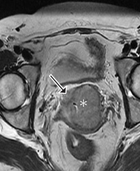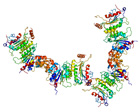 As UHN's monthly research newsletter, NRx reports on the full spectrum of leading research from UHN's five research institutes. Located in downtown Toronto, these institutes are the Princess Margaret (PM) Cancer Centre, the Toronto General Research Institute (TGRI), the Toronto Western Research Institute (TWRI), the Toronto Rehabilitation Institute (TRI) and the Techna Institute (Techna).
As UHN's monthly research newsletter, NRx reports on the full spectrum of leading research from UHN's five research institutes. Located in downtown Toronto, these institutes are the Princess Margaret (PM) Cancer Centre, the Toronto General Research Institute (TGRI), the Toronto Western Research Institute (TWRI), the Toronto Rehabilitation Institute (TRI) and the Techna Institute (Techna).
In this issue you can read about:
- New insight into how the retina repairs itself
- The importance of social support for recovery from brain injury
- UHN software that can anticipate changes in tumour size
- A new marker that may identify the earliest stages of leukaemia
- Improving the quality of life of terminally-ill cancer patients
- The factors that influence opioid dependency after surgery
We hope that you will find NRx informative. If you have feedback or questions, please contact www@uhnresearch.ca.
Christopher J. Paige, PhD, FCAHS
Vice President, Research
University Health Network

Astrocytes are cells within the central nervous system (brain, spinal cord and retina) that provide nutrients, maintain balanced conditions and mediate cell repair.
Cells within the retina are highly prone to damage. They are frequently exposed to light (solar radiation) and require high levels of energy to function properly. While many diseases, including diabetic retinopathy and glaucoma, result from damage to retinal cells, little is currently known about the molecular mechanisms that protect these cells.
Taking clues from the brain, TWRI Scientist Dr. Jeremy Sivak explored the role of a protein known as PGC-1α, which has been shown to act as a gateway for repair and detoxification in the brain. Dr. Sivak’s team found that a specific population of cells in the retina, known as astrocytes, also contain the PGC-1α protein. Detailed studies revealed that PGC-1α enables these cells to respond to damage and mediate repair by activating a number of downstream detoxifying genes, which leads to increased energy production and quenching of harmful oxidizing chemicals.
Dr. Sivak comments, “By revealing the underlying molecular events that mediate protection of cells within the retina, these results could allow researchers to enhance natural repair mechanisms to prevent degeneration of neurons responsible for some of the most common vision loss disorders.”
Supported by the Canadian National Institute for the Blind, the Canadian Institutes of Health Research, the Glaucoma Research Society of Canada and the Toronto General & Western Hospital Foundation.
PGC-1a signaling coordinates susceptibility to metabolic and oxidative injury in the inner retina. Guo X, Dason ES, Zanon-Moreno V, Jiang Q, Nahirny A, Chan D, Flanagan JG, Sivak JM. American Journal of Pathology. 2014 February 5. [Pubmed abstract]

Brain injuries from physical trauma—such as the accident that cracked this bicycle helmet—led to less long-term care needs after rehabilitation than injuries from non-traumatic causes.
Brain injuries are a major cause of disability. After the initial hospital stay, many patients will enter inpatient rehabilitation care to improve physical, emotional and social functions with the ultimate goal of returning home after discharge. Due to the complex nature of brain injury, addressing all of the challenges that affect quality of life is difficult, and little information exists to help guide clinicians. Fortunately, Ontario comprehensively tracks inpatient rehabilitation, providing the data that Toronto Rehab Senior Scientist Dr. Angela Colantonio and colleagues used to examine the factors that affect patient rehabilitation and their return home.
The study found that those who had sources of "informal support" like close friends and family were more likely to return home after being discharged from rehabilitation than those who lived alone. Older adults with brain injury from causes other than physical trauma—such as brain infections, substance abuse or tumours—were more likely to have greater needs for residential care; with the aging population this may indicate a need to start expanding the capacity of these facilities. Improving physical function and providing needed support at discharge may help reduce the demand for residential care facilities.
"Our findings suggest that patients with all types of brain injury require specific discharge planning," says Dr. Colantonio.
This work was supported by the Ontario Neurotrauma Foundation, the Toronto Rehabilitation Institute, University Health Network and the Ministry of Health and Long-Term Care, and the Toronto Rehab Foundation. The views expressed do not necessarily reflect those of the Ministry. Image credit: http://www.flickr.com/photos/ashkyd/4564445323/.
Factors associated with living setting at discharge from inpatient rehabilitation after acquired brain injury in Ontario, Canada. Chen A, Chan V, Zagorski B, Parsons D, Colantonio A. Journal of Rehabilitation Medicine. 2014 January 30. [Pubmed abstract]

MR images can help accurately measure the size of a cervical tumour, like the one above. With computer modelling of shape changes, fewer scans may be needed.
Radiation therapy involves directing beams of radiation at a tumour to kill the cancerous cells and requires a careful balance of maximizing the dose to the tumour while minimizing the dose to the healthy tissues around it. Maintaining this balance is complicated by the fact that tumours change size and shrink during the weeks-long course of treatment. To address this issue, Techna Affiliated Faculty Dr. Mohammad Islam and colleagues have developed a computer model that simulates tumour shrinkage in cervical cancer.
The model was developed by examining detailed weekly magnetic resonance (MR) imaging scans of patients being treated for cervical cancer. While images such as these could be used by clinicians to adjust delivery of radiation to account for changing tumour volume, repeated MR images are expensive to acquire. The computer simulation can predict the expected changes in tumour volume, allowing modifications in the radiation delivery to be planned in advance, in combination with less frequent imaging to confirm reductions in tumour size.
Adapting the treatment delivery to the changing shape of the tumour will lead to better outcomes for patients by sparing more of the surrounding healthy tissue. This model could also be used as a benchmark for clinicians to evaluate if the tumour is responding therapy, or whether an alternate patient-specific approach is required.
This work was supported by the Ontario Research Fund, Mitacs and The Princess Margaret Cancer Foundation. Image credit: Radiology Research and Practice. 2012; 2012: 219546.
A stochastic model for tumor geometry evolution during radiation therapy in cervical cancer. Liu Y, Chan TC, Lee CG, Cho YB, Islam MK. Medical Physics. 2014 February. [Pubmed abstract]

Mutations in a protein known as DNMT3a (pictured above) may be present in healthy adults and pre-date AML diagnosis by months or even years.
Although a number of genomic mutations have been implicated in acute myeloid leukaemia (AML), the path or series of molecular events that connect early mutations to the eventual development of leukaemia have not been fully defined. Moreover, it is still unclear what impact these early mutations have on AML or if a pre-leukaemic stage of the disease exists before it is diagnosed.
McEwen Researcher Dr. John Dick and his research team including lead authors Liran Shlush and Sasan Zandi have provided provocative answers to these questions through detailed analyses of defined blood cell populations from patients with AML.
Using a comprehensive purification scheme developed in his lab, Dr. Dick and his team isolated highly purified stem and progenitor populations from the blood of leukaemia patients. Analysis of these cell populations revealed that they functioned normally and were not leukaemic. Although these cells did not contain mutations normally found in leukaemia, they did predominantly carry a mutation in the DNMT3a gene, identifying them as pre-leukaemic ancestors of the AML. Identification of these pre-leukaemic cells may represent a new marker to detect AML before the disease actually develops. Interestingly, these pre-leukaemic cells were able to survive chemotherapy and were present in patients that were in remission.
These findings provide a new paradigm in our understanding of early AML development: they serve as a call for the development of early detection and treatment approaches that target mutated pre-leukaemic cells, and may provide new ways to monitor disease status in patients in remission.
This research was supported by the Canadian Institutes of Health Research, the Canadian Cancer Society, the Terry Fox Foundation, Genome Canada through the Ontario Genomics Institute, the Ontario Institute for Cancer Research, The Princess Margaret Cancer Foundation, and the Ontario Ministry of Health and Long-Term Care. J Dick holds a Tier 1 Canada Research Chair in Stem Cell Biology.
Identification of pre-leukaemic haematopoietic stem cells in acute leukaemia. Shlush L, Zandi S, Mitchell A, Chen WC, Brandwein JM, Gupta V, Kennedy J, Schimmer A, Schuch AC, Yee KW, McLeod J, Doedens M, Medeiros J, Marke R, Kim HJ, Lee K, McPherson JD, Hudson TJ, The HALT Pan-Leukemia Gene Panel Consortium, Brow AMK, Trinh QM, Stein LD, Minden MD, Wang JCY, Dick JE. Nature. 2014 January 11. [Pubmed abstract]

Palliative care addresses the psychological, physical and spiritual needs of patients with life-threatening illness and their family members.
The World Health Organization recommends that all terminally ill patients receive palliative care, which is designed to alleviate the suffering of people with life-threatening illnesses, to improve their quality of life and the wellbeing of their family. A recent study, published in the leading medical journal The Lancet, may improve the wellbeing of these patients by changing how and when palliative care is delivered.
Led by PM Cancer Centre Scientist Dr. Camilla Zimmermann, the clinical study enrolled 461 patients diagnosed with terminal cancer who had estimated life expectancies of 6-24 months. One half of the patients received standard cancer care, which typically only provides palliative care in the last two months of life. The other half of patients were provided with early palliative care, including monthly consultations with a physician and nurse who provided specialized care and support.
After four months, researchers noted significant improvements in the quality of life of patients participating in the early palliative care program compared to those receiving standard care. Moreover, early palliative care improved the patients' ability to cope with their symptoms and increased their satisfaction with care.
This work was supported by the Canadian Cancer Society, the Ontario Ministry of Health and Long-Term Care, and The Princess Margaret Cancer Foundation.
Early palliative care for patients with advanced cancer: a cluster-randomised controlled trial. Zimmermann C, Swami N, Krzyzanowska M, Hannon B, Leighl N, Oza A, Moore M, Rydall A, Rodin G, Tannock I, Donner A, Lo C. The Lancet. 2014 February 18. [Pubmed abstract]

At the individual level the risk of persistent opioid use is low; however, from a population perspective, more research and targeted interventions are needed for the 3% of patients at risk.
Opioids are commonly prescribed to reduce postoperative pain; however, factors that affect how long patients typically use opioids after major surgery are currently unknown. To help address this question, TGRI Clinical Researcher Dr. Hance Clarke and his research collaborators analyzed records from multiple databases to identify the key factors that influence opioid use in patients undergoing major surgery at acute care hospitals across Ontario.
Findings from the study revealed that approximately 3% of patients continued opioid use for more than three months after surgery. The team's analysis also identified age, income and type of surgery as factors that influenced whether patients prolonged the use of opioids post-surgery.
Dr. Clarke explains, "Our findings may help patients and clinicians understand the risks associated with prolonged opioid use after surgery. This might help clinicians to ensure that low-risk surgical patients have access to opioids for pain relief and that high-risk patients receive targeted interventions that mitigate their risk of prolonged opioid use."
This work was supported by the Canadian Institutes of Health Research, the Heart and Stroke Foundation of Ontario, the Institute for Clinical Evaluative Sciences, which is supported in part by the Ontario Ministry of Health and Long-Term Care, and the Toronto General & Western Hospital Foundation.
Clarke H, Soneji N, Ko DT, Yun L, Wijeysundera DN. Rates and risk factors for prolonged opioid use after major surgery: population based cohort study. BMJ. 2014 February 11. [Pubmed abstract]
 Between February 10th and 11th, the PM Cancer Centre hosted a conference titled, "Beyond the Genetic Prescription Pad: Personalizing Cancer Medicine in 2014".
Between February 10th and 11th, the PM Cancer Centre hosted a conference titled, "Beyond the Genetic Prescription Pad: Personalizing Cancer Medicine in 2014". The Canadian Cancer Society released a list of the top research discoveries of 2013 that changed the landscape of cancer, which included work from PM Cancer Centre's Dr. Camilla Zimmermann.
The Canadian Cancer Society released a list of the top research discoveries of 2013 that changed the landscape of cancer, which included work from PM Cancer Centre's Dr. Camilla Zimmermann. The 2014 ASME (Association for the Study of Medical Education) Gold Medal Award was recently presented to Dr.
The 2014 ASME (Association for the Study of Medical Education) Gold Medal Award was recently presented to Dr.